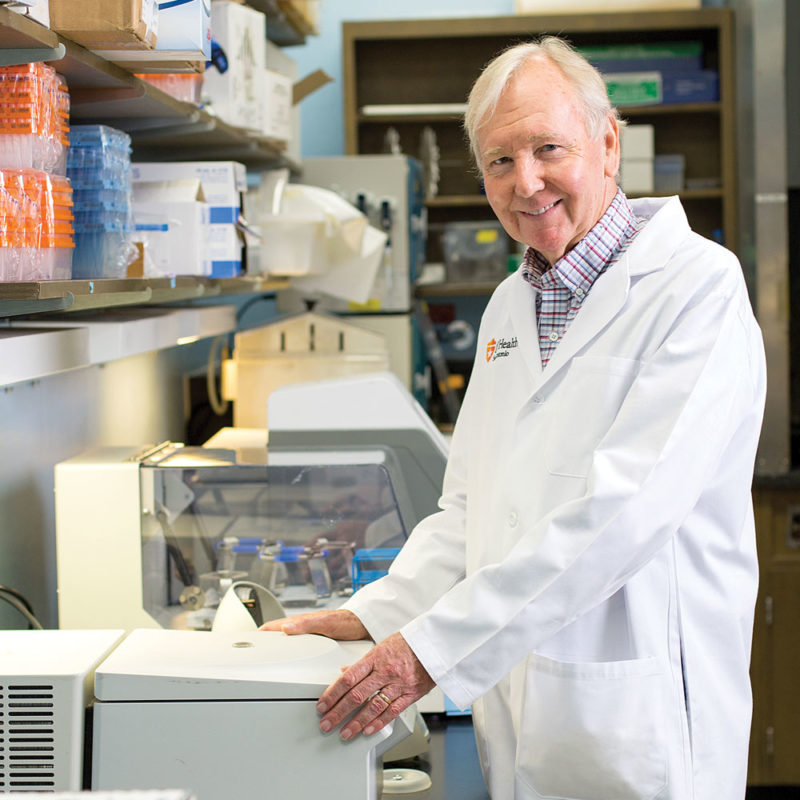Blazing a Trail


Bone Biologist Applies Five Decades of Experience to Periodontic Research
By Catherine Duncan
At a time when many of his colleagues are enjoying retirement, Stephen E. Harris, Ph.D., is awarded an esteemed Research Project Grant—also called an R01—from the National Institutes of Health to continue conducting cutting-edge molecular research.
Dean William W. Dodge, D.D.S., said Dr. Harris epitomizes perseverance and the ability to achieve success regardless of age. “At 70-plus years of age, he was recently awarded an R01—a fantastic achievement by any count. He has long supported research in the Department of Periodontics, and we are fortunate to benefit from his experience and innovation.”
Dr. Harris, professor and director of research for the Department of Periodontics, began his research career in gene regulation in 1965 while pursuing his Bachelor of Art in Zoology from UT Austin. His education and research continued as he earned a Master of Art in Biochemical Genetics and a Ph.D. in Biochemical Embryology, both from UT Austin.
In 1990, he began studying bone and teeth with Gregory R. Mundy, M.D., then professor of cellular and structural biology in the Department of Medicine. During this time he also worked on computational and theoretical models of gene regulation at the transcription level.
In 1999, Dr. Harris began various complexity and systems biology approaches in the lab to study large sets of gene expression pattern with microarrays and regulation by Recombinant Human Bone Morphogenetic Protein 2 (Bmp2) in osteoblast models. In 2001, he worked on developing mouse and cell culture models of osteocytes—the most commonly found cell in mature bone tissue—while on sabbatical at the School of Dentistry at the University of Missouri at Kansas City.
When Dr. Harris returned to San Antonio, he learned that David L. Cochran, D.D.S., Ph.D., professor and chair of periodontics, had a position open for director of research. After taking this job, he took his research in bone biology and began working with mouse models in the area of periodontics.
In 2013, the International Journal of Oral Science featured his research showing that Bmp2 controls the differentiation of cells giving rise to the crown, root and periodontium.
With the NIH grant awarded in 2015, Dr. Harris and his research team, including his wife, Marie, and graduate student Audrey Rakian, D.D.S., Ph.D., are taking past models of ribonucleic acid (RNA) involved in gene regulation in the late 1960s and using them to study how genes turn on and off using protein transcription factors with associated enhancer RNAs.
“You can take a tumor or cyst from one patient and look at it to see all the different kinds of cells in it, or a cell model of differentiation, using methods of single cell transcription studies. We can see what we need to target to fix it or understand the complexity of the various cell types,” he said. “We are looking at a class of stem cells in the bone and the jaw. We are removing the Bmp2 gene so we can figure out how the periodontium, which works as shock absorbers and plays many other functions, are formed and function.”
Just as endodontics has been studying how to use stem cells to stimulate teeth to continue growing and developing as part of root canal treatment, “we are taking that principal to periodontics. The loss of bone around teeth often means the loss of the teeth.
“How can we activate the patient’s stem cells so they can start regrowing? We need new ways to regenerate the alveolar bone and periodontal ligament and cementums,” he said. “We are pretty sure it is one major group of cells called Alpha SMA positive periodontal stem cells. In my lab, Dr. Rakian has carried out lineage tracing to show how those stem cells produce the bone and periodontal ligament and cementums around the tooth.
“When you remove the Bmp2 gene, the process is defective. If we can figure out how to activate Bmp2, we can treat periodontal bone loss.”
Dr. Cochran describes Dr. Harris as an “outstanding scientist who loves his work and science with all his heart. He is selfless in sharing his expertise, and he is always open to helping others.”
